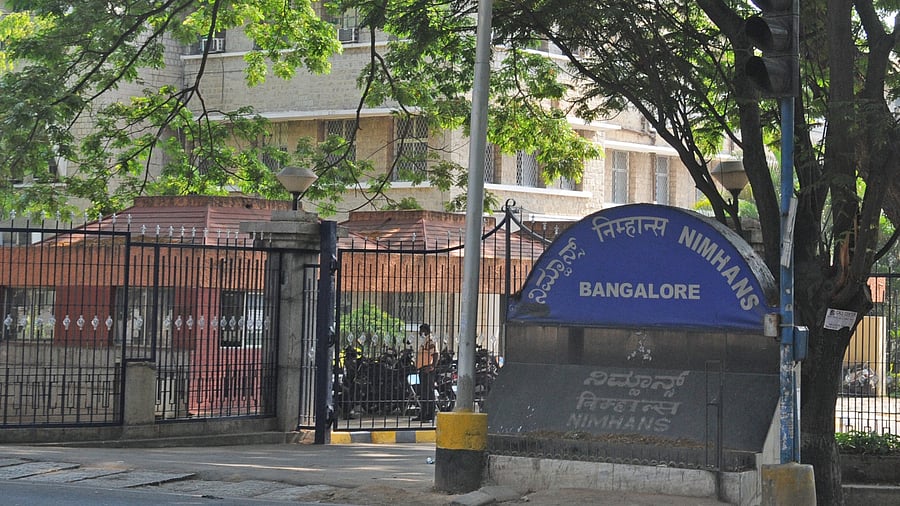
National Institute of Mental Health And Neuro Science (NIMHANS) in Bangalore.
Credit: DH Photo
This year marks 70 years since the establishment of the first post-graduate centre for psychiatry and other fields of mental health in independent India, the All India Institute of Mental Health, or AIIMH.
The AIIMH and the mental hospital were amalgamated to form the National Institute of Mental Health and Neurosciences, or NIMHANS, in 1974.
The current year is special as it celebrates these two milestones of this prestigious institution. It is thus apt to chronicle not just its growth as an institute of national repute but also to share current important learnings in the fields of mental health and neuroscience. This is the first of a series of articles on this theme describes the evolution of NIMHANS to its current stature.
Anyone who knows Bengaluru from the 19th and 20th centuries will be familiar with the busy Avenue Road and the Pete area, where all business was conducted. But few know that where the Avenue Road now joins the Kempegowda Road, stood the Lunatic Asylum, constructed in the middle of the 19th century. The building still stands today. It was earlier the head office of the State Bank of Mysore and now houses the State Bank of India. In 1925, the Lunatic Asylum was renamed the Mental Hospital. Dr Francis Noronha was its medical superintendent between 1922 and 1925. The hospital became insufficient to house the growing need to care for people with mental illness. It was the largesse of His Highness Sri Krishna Rajendra Wadiyar Bahadur and the efforts of the then Dewan of Mysore, Sir Mirza Ismail, that the government sanctioned the building in 1936. The Mental Hospital shifted to the current premises in November 1937. The sale of the old building is said to have fetched Rs 2.5 lakh, which was used towards the building of the new hospital.
Gustav Krumbiegel, the chief consulting architect for the Government of Mysore, and Dr Francis Noronha were involved with the design of the original building and gardens. The architecture was entrusted to a firm, MEC. The AIIMH was started at this site in 1954 by Rajkumari Amrit Kaur, and Dr M V Govindaswamy became the first director.
From about 300 beds only for psychiatry, the institute has now expanded to 1,098 beds in psychiatry, neurology, and neurosurgery. Since 1995, when only two postgraduate diploma courses in psychiatry and medical psychology were offered, presently more than 90 postgraduate courses are offered. Apart from the central campuses flanking Hosur Road, there is the Sakalwara campus, the Centre for Well-Being, and the campus in North Bengaluru, where a poly-trauma centre is envisaged.
There has been a substantial growth in the understanding and approach to illness and the well-being of the mind and brain. The story of NIMHANS exemplifies this. It is the story of how an institute with humble beginnings as a mental hospital transformed into a vibrant, multi-disciplinary, internationally renowned institute of national importance.
It is important that the expansion of knowledge in the field translates into better care for our citizens. Equally, we need to educate ourselves on how to maintain optimal health. Mental health also includes mental and physical well-being. Mental well-being is also important for personal growth and accomplishment. From exercise and yoga to learning about introspection and altering the way we think, feel, and behave, there is a lot we can do to help ourselves.
Sleep, diet, and exercise are also important for optimal physical and mental health. In an ever-changing society, transition brings its own set of problems. The stress of modern living, interpersonal strife, and growing recognition of depression, anxiety, and substance use are all areas that need attention. Digital technology offers solutions to reaching out for help, but it also brings its own set of complexities. Lack of social support and loneliness are well-known triggers for mental distress and mental health problems. While there is a growing acceptance of help-seeking for mental health problems, stigma surrounding it persists.
Availability and access to timely mental health care is also a challenge, which newer, technology-driven initiatives like the Telemanas are trying to address. Severe mental illnesses like schizophrenia, bipolar mood disorders, and other psychotic disorders, although less common, are associated with premature mortality as well as tremendous disability and need early recognition, timely treatment, and continued care. There are distinct mental health problems that children, young adults, and the elderly face, and we need to understand and address their special needs.
In this series, we hope to focus on some of these issues, from how to address the mental health needs of children to people with dementia, and maintaining positive mental health.
(The writer is Director, NIMHANS. This is the first of a
DH-NIMHANS series on mental health)